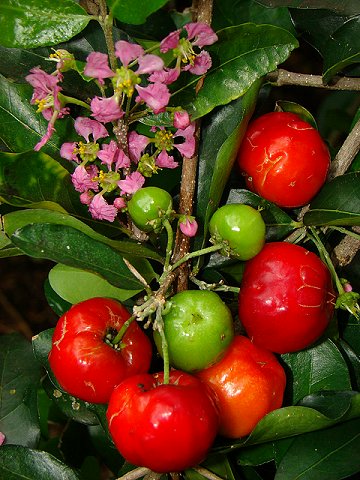
|
|
Acerola (Malpighia emarginata DC, Malpighia glabra L., Malpighia
punicifolia). Flower and fruit.
|
Acerola - Malpighia
spp.
Acerola (Malpighia emarginata DC, Malpighia glabra L., Malpighia
punicifolia) is a tropical fruit-bearing shrub or small tree in the family Malpighiaceae. Common names include acerola, Barbados cherry, West Indian cherry and wild crepemyrtle. Acerola is native to South America, Southern Mexico and Central America, but is now also being grown as far north as Texas and in subtropical areas of Asia, like India. It is known for being extremely rich in vitamin C, almost as much as camu camu, although it also contains vitamins A, B1, B2 and B3 as well as carotenoids and bioflavonoids which provide important nutritive value and have antioxidant uses. The vitamin C produced by the fruit is better absorbed by human organisms than synthetic ascorbic acid.
There are several different species of acerola, including Malpighia glabra L., Malpighia punicifolia L., Malpighia emarginata
D.C.. Malpighia glabra has one of the highest content of natural vitamin C per gram of
fruit. Sometimes researchers mention acerola as being Malpighia emarginata and it is not clear to us how similar or different Malpighia emarginata and Malpighia glabra are to each
other. A distinction is sometimes made in nomenclature between wild and cultivated
(improved) plants, the latter being called M. punicifolia L. It is now, however, generally accepted that both taxa belong to M.
glabra. M. coccigera L. and M. urens L. are incidentally cultivated in South-East Asia for the same purposes as M.
glabra.
M. emarginata is originally from Yucatan, and can be found in Mexico, Central America, the Caribbean, South America as far south as Peru and the south east region in Brazil, and in the southernmost parts of the contiguous United States (southern Florida and the Lower Rio Grande Valley of Texas). It is cultivated in the tropics and subtropics throughout the world, including the Canary Islands, Ghana, Ethiopia, Madagascar, Zanzibar, Sri Lanka, Taiwan, India, Java, Hawaii, and
Australia.
Acerola can be propagated by seed, cutting and other methods. Seeds unfortunately can have low germination
rates. Seeds are generally very slow to germinate, usually requiring from 6 to 12 months at
minimum. Acerola prefers dry sandy soil and full sun, and cannot endure temperatures lower than 30°F. Because of its shallow roots, it has very low tolerance to
winds.
Acerola is an evergreen shrub or small tree with spreading branches on a short
trunk. It is usually 2–3 m (6.6–9.8 ft) tall, but sometimes reaches 6 m (20
ft) in height. Acerola's often form small multi-trunked
trees. The leaves are simple ovate-lanceolate, 2–8 cm (0.79–3.1 in)
long, 1–4 cm (0.39–1.6 in) wide, and are attached to short petioles. They are
opposite, ovate to elliptic-lanceolate, and have entire or undulating margins with small
hairs, which can irritate skin.
Flowers are bisexual and 1–2 cm (0.39–0.79 in) in diameter. They have five pale to deep pink or red fringed petals, ten stamens, and six to ten glands on the calyx. There are three to five flowers per inflorescence, which are sessile or short-peduncled axillary
cymes. Flowers usually appear after periods of rainfall or
irrigation. Flowering may occur any time during the year (depending on local rainfall and climate
patterns), and can last year-round.
After flower set, fruit soon follows and will ripen in just 3-4
weeks. Fruits lose their flavor and nutritional content very rapidly upon
harvest. Ripe acerola's should be picked and eaten within a few hours to preserve
taste. As a result, the tree is not cultivated for commercial production of fresh
fruits. Trees without adequate pollination can set seedless fruit.
The fruit is a bright red drupe 1–3 cm (0.39–1.2 in) in diameter with a mass of 3–5 g (0.11–0.18 oz). Drupes are in pairs or groups of three, and each contains three triangular seeds. The drupes are juicy and very high in vitamin C(3-46g kg-1) and other nutrients. They are divided into three obscure lobes and are usually acid to subacid, giving them a sour taste, but may be sweet if grown well. While the nutrient composition depends on the species and environmental conditions, the most common components of acerola and their concentration range are as follow: proteins (2.1-8g), lipids (2.3-8g), carbohydrates (35.7-78g), calcium (117 mg), phosphor (171 mg), iron (2.4 mg), pyridoxine (87 mg), riboflavin (0.7 mg), thiamine (0.2 mg), water (906-920g) and dietic fibre (30g).
The fruit is edible and widely consumed in the species' native area, and is cultivated elsewhere for its high vitamin C content. Fruit resembles the common cherry, with a very tasty sweet flavor having a slight bite of
acid. There are 1677.6 mg of vitamin C in 100 g of fruit. Frruit has vitamin C content up to 65 times that of an orange. The sour fruits are eaten
fresh, but more often preserved with sugar, e.g. in the form of jam. Commonly used in parts of South America to flavor ice
creams, drinks, and cocktails. Commercial production mainly supplies beverage
makers, and for additives in nutritional products. Acerola's are not usually sold as a fresh
fruit. Fruit can be used to make juices and pulps, both very rich in vitamin C and
antioxidants.
Acerola fruit can be used to produce vitamin C concentrate, in baby food and juice
The fruits are considered beneficial against liver
problems, diarrhoea, dysentery, coughs and colds.
It is one of three ingredients in a proprietary herbal medicine for allergic
rhinitis.
Acerola is a popular bonsai subject because of its small leaf, fruit and fine
ramification. It is also grown as an ornamental and for hedges.
Source:
http://en.wikipedia.org/wiki/Malpighia_emarginata
http://www.tradewindsfruit.com/acerola.htm
http://www.worldagroforestry.org/sea/products/afdbases/af/asp/
SpeciesInfo.asp?SpID=18085
